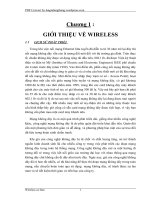Wireless Communications
Bạn đang xem bản rút gọn của tài liệu. Xem và tải ngay bản đầy đủ của tài liệu tại đây (282.7 KB, 18 trang )
Wireless Communications
Radio Frequency Identification
2
Objectives
•
Define Radio Frequency Identification (RFID)
•
Explain the need for RFID and how RFID works
3
What is RFID?
•
Radio frequency identification (RFID)
–
Technology similar to barcode labels
–
Uses radio frequency waves instead of laser light to
read the product code
–
Stores product information in electronic tags
•
That contain an antenna and a chip
4
RFID System Components
•
Electronic Product Code (EPC)
–
Standardized numbering scheme
–
Can be programmed in a tag and attached to any
physical product
–
Unique number or code associated with each item
•
So that it can be identified electronically
–
EPCs usually represented in hexadecimal notation
–
EPC is either 64 or 96 bits long
5
RFID System Components (continued)
6
RFID System Components (continued)
•
RFID tags
–
Commonly known as transponders
•
A combination of transmitter and responder
–
Includes an integrated circuit
•
Contains some non-volatile memory and a simple
microprocessor
–
Can store data that is transmitted in response to an
interrogation from a reader
•
Device that captures and processes the data received
from the tags
7
RFID System Components (continued)
•
RFID tags (continued)
–
Basic types of tags
•
Passive tags (most common type)
–
They are small, can be produced in large quantities
at low cost, and do not require battery power
–
Use the electromagnetic energy in the RF waves
•
Active tags
–
Equipped with a battery
–
Can transmit the signal farther away
–
Have a limited life due to the battery
–
Beacons transmit on a periodic basis









